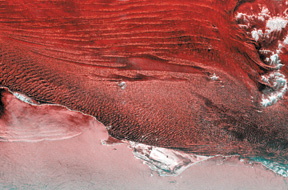Geotimes

News
Notes
Climate Policy
Cracking
abrupt climate change
Large, abrupt climate changes
punctuate the paleoclimate record. Because such changes are not well reproduced
by the present generation of climate models, similarly abrupt changes could
surprise us in the future, says a new report from the National Academies’
National Research Council (NRC).

This SIR-C/X-SAR image shows
part of the vast Namib Sand Sea on the west coast of southern Africa. The
magenta areas are fields of sand dunes, and the orange area along the bottom
is the surface of the South Atlantic Ocean. Steep dunes organize the sands,
causing bright radar reflections off the dune faces. Bright green signifies
rocky hills poking through the sand sea. Because the region receives only
a few centimeters of rain per year, radar images of this hyper-arid region
often image sub-surface features. The NRC report on abrupt climate change
stresses the importance of studying unique hydrologicl areas to better
understand and predict future changes in the water cycle, including droughts
and floods. NASA/JPL
Whereas most climate change
research has focused on slow, gradual changes, the NRC report says future
research should aim to understand and plan for sudden changes. “Our research
into global change should involve a real target on abruptness,” says Richard
Alley, chair of the NRC’s Committee on Abrupt Climate Change, which authored
the report.
The NRC report, Abrupt Climate
Change: Inevitable Surprises is a collaborative study among the Board on
Atmospheric Sciences and Climate, the Polar Research Board and the Ocean
Studies Board. It aims to fill a gap in the information provided by the
climate community to the scientific and policy communities about abrupt
climate change.
The report defines an “abrupt”
change as one where the climate response is faster than the changes causing
it. On a human time scale abrupt is “something that is fast enough that
ecosystems or economies have trouble dealing with it,” Alley says. The
changes could affect temperature, precipitation, evaporation and extreme
weather events.
The warming at the end of
the Younger Dryas cold interval 11,600 years ago, for example, triggered
an abrupt cooling period followed by an abrupt warming. These changes occurred
over 10 years but accounted for one-third to one-half of the climate difference
from the ice age to present-day conditions. “So you’ve got 100,000 years
to end an ice age but you get almost half of it in 10 years. That’s an
abrupt change,” Alley says.
Alley adds that climate models
have failed to represent such abruptness, increasing the chances for surprise
in the future. “There’s a general impression that the big, inclusive global
models don’t behave quite as abruptly as the real world does,” Alley says.
“There are no surprises in
this report for anyone who has followed debates within the climate community
over the past decade,” says Matt Huber, a paleoclimate researcher at the
Danish Center for Earth System Science. “The report is a good snapshot
of the current scientific consensus.”
While the nature of the report’s
data and methods are excellent, Huber says, it has a narrow focus that
may limit the scope of its voice. Drawing on instrumental and social science
data as well as high-resolution paleoclimate records, such as ice core
data, the report largely focuses on more recent climate events. These include
thorough treatments of the events before the Younger Dryas cold interval,
the Younger Dryas itself, the Eemian, the Holocene, and encompass climate
changes, trends and modes of variability in the instrumental period. “Thus,
the entire history of climate has been telescoped down so that the most
recent periods receive the vast majority of the attention, and the view
is mostly through the lens of ice cores.”
Documentation of past abrupt
climate changes is much better in colder regions such as Greenland and
Antarctica than in warmer regions such as the Pacific and tropics. The
report acknowledges these gaps, and therefore does not include much discussion
of abrupt changes in past warm climate periods. The committee does recommend
improving the geographic and temporal breadth of paleoclimate data, and
including these proxies in models.
Kevin Trenberth, head of
the National Center for Atmospheric Research’s Climate Analysis Section,
says the NRC analysis represents the step forward climate models need to
take to incorporate feedback processes that drive abrupt climate changes.
At the end of the Younger Dryas, for example, melting of the large ice
sheet over North America and the North Atlantic caused freshwater to flow
into the ocean and change the seawater’s density. Changing this thermohaline
circulation “can completely change ocean circulation behavior, presumably
on time scales of a few years, and so this is one of the things you have
to have in a model,” Trenberth says.
Models that omit these processes
cannot predict future changes that could result from a similar flushing
of the North Atlantic, Trenberth adds. Global warming could melt glaciers
and increase overall evaporation resulting in this flushing process. Such
a change in the ocean’s circulation could deliver a cold spell to places
such as Western Europe and increase heat elsewhere on Earth. Only by understanding
these climate feedbacks throughout the geologic record, Trenberth says,
can models accurately simulate global changes.
“In general, most of the
recommendations of the panel are good and should lead to a focus on fruitful
avenues: monitoring of the thermohaline circulation and the hydrological
cycle, improved computer models, improved paleoclimate proxy data sets,”
Huber says.
Lisa M. Pinsker
Read about abrupt
warming at the Late Paleocene Thermal Maximum
Related
Links:
Read the prepublication copy
of Abrupt Climate Change:
Inevitable Surprises
Visit the National
Center for Atmsopheric Research Web site


